The product recommendations in this post are recommendations by the writer and/or expert(s)
interviewed and do not contain affiliate links. Meaning: If you use these links to buy
something, we will not earn a commission.
Food prices in America continue to be astronomical across the board. The cost of beef, in particular, is rising, which isn’t great news for steak lovers. But, as you may have experienced firsthand, restaurants–including steakhouses–have seen the largest price jumps of all, with overall costs up almost 8% compared to 2022, according to the Consumer Price Index.
Just to give you an idea, if you visited the popular chain Ruth’s Chris Steak House today, you could expect to pay a minimum of around $61 for a 16-ounce New York strip and close to $69 for the same-size ribeye. Even at more economical steak joints such as LongHorn, you’re still looking at a check of up to $33 for one cut of meat.
With that being said, however, a perfectly charred and cooked restaurant steak is hard to beat, and top steakhouse chefs explain why it’s such a one-of-a-kind, worth-the-money experience.
“Most meals that you would enjoy in a restaurant can be difficult to duplicate at home just from the pure BTU (British Thermal Unit) perspective that commercial kitchen equipment can produce,” says chef Roger Rungpha, executive chef for San Francisco-area steakhouse LB Steak. “It is a hard thing to replicate a professional sear and cooking something in a few minutes in a restaurant kitchen versus cooking the same cut at home in double the time at a lower temp on consumer grade equipment. It’s also great to go out and support your favorite restaurant and let us do the work.”
But, when you just can’t swing the added moolah–or maybe you’re simply wanting to get your own hands dirty and experiment in the kitchen yourself–cooking a delicious juicy steak at home is definitely a viable option, and one which can be very rewarding.
“Restaurants have the right tools to be able to execute steaks to perfection,” says Alvaro Machado, corporate chef at SuViche Hospitality Group, which operates multiple Miami restaurants, including the Argentinian steakhouse Novecento. “However, there’s also nothing better than executing the perfect steak at your house and being able to reach the right cooking temperature, as well as allowing the steak to have the perfect pink color–it’s super satisfying.” Cooking a steak at home also gives you full control over the seasonings and marinades, cooking techniques, and final temperature of your cuts.
In order to get the job done the right way, experienced chefs also share their recommendations for the best steaks to tackle at home that are foolproof even for the most novice of cooks. Additionally, don’t forget other important tips from chef Machado as you embark on your steak journey, such as always using a meat thermometer, marinating ahead of time, and allowing the steak to reach room temperature before cooking.
Here are the five best cuts to cook at home, according to restaurant pros.
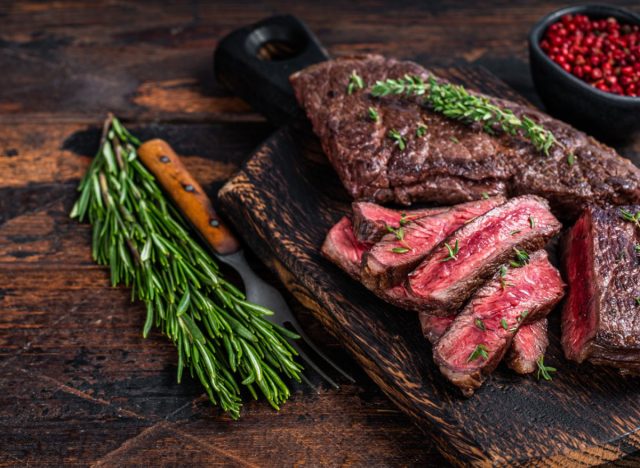

Skirt steak–known as entraña in Argentinian cooking–is a long and flat cut of meat which comes from the belly of the cow. Chef Machado says its thin nature makes it “easy to execute at home in a grill or a cast iron skillet and it takes no longer than 4 minutes each side for a nice medium-rare temperature.”
Barry Sorkin, pitmaster and one of the co-owners of Smoque Steak in Chicago, likes skirt steak because he says it’s “a great rich and beefy steak” and tends to be less expensive than cuts like ribeyes or New York strips.
“Skirt steak can be chewy, especially if over or under-cooked. But, proper slicing (across the grain) will deliver a deliciously rich and easy-to-eat steak,” Sorkin says. “Ask your butcher to make sure it’s peeled and trimmed of excess surface fat, but don’t let them put it through the tenderizing machine. It will tenderize it, yes, but it will also rob the steak of its natural structure, texture, and juiciness.”
At Sorkin’s Smoque Steak restaurant–where the chefs deploy a smoke and sear method on their prized cuts–the skirt steak is topped with a red chimichurri and accompanied by bistro fries.
READ RELATED: Comprehensive Approach To Hepatobiliary Disorders: Diagnosis And Management
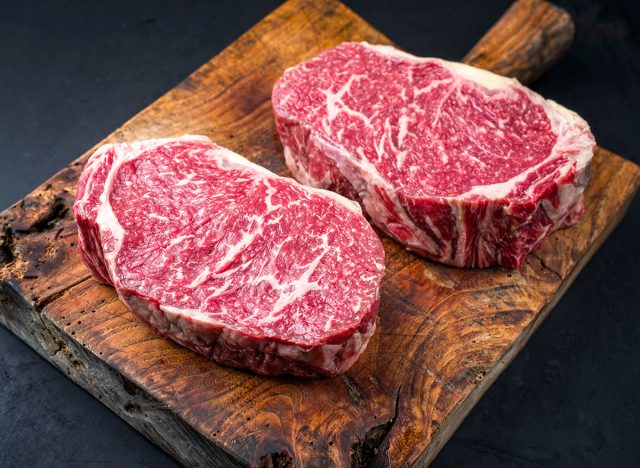

The ribeye, one of the most popular and flavorful cuts of steak, was also one of the most popular choices among our surveyed chefs.
“My favorite cut for cooking up at home would have to be the ribeye,” says chef Rungpha of LB Steak. “I love this cut because of the flavor of the spinalis dorsi (muscle over the eye if the rib eye). You are getting the best of both worlds; something that is toothsome in the eye and a lot of fat in the cap. You want to sear it, then let it cook slowly to give the heat time to properly render the fat. Hands down it has the most amazing texture and flavor of any cut.”
Chef Machado also puts the ribeye on a pedestal because of its fat ratio which makes it especially delicious. Like chef Rungpha, Machado also prefers to use a skillet and usually opts for a 14-ounce or 16-ounce for this particular cut. The Argentinian chef sears it on each side for about five minutes before finishing it off in the oven for about 7 minutes at 350 degrees.
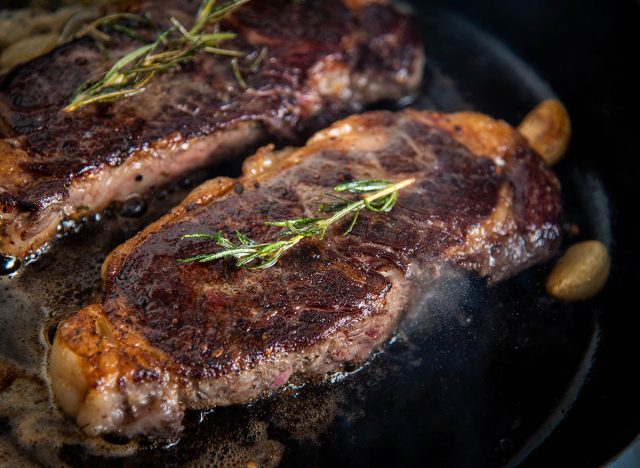

Crafty at-home chefs can also find cooking bliss with a New York strip. Michael Senich, corporate executive chef at Darden-operated LongHorn Steakhouse, says that strip steaks are readily available at the grocery store and are typically one-muscle steaks, making them easier to cook consistently.
“Porterhouses and T-Bones are more difficult to cook due to them having two separate muscles–the NY strip and the tenderloin. It can be challenging to get the temperature right for both muscles,” he warns.
There are several ways you can go about cooking this cut at home, according to chef Senich–and you really can’t go wrong with any of them. “If the weather is right, I always try to cook my steaks on an outdoor grill just to get that extra flavor from the open flame,” he shares. “For the stovetop, a cast iron skillet is my backup plan. The skillet provides an excellent sear and crust. The cast iron can also be used to get a hard sear on the steaks and then, you can place them in an oven to finish bringing them up to your desired level of doneness.”
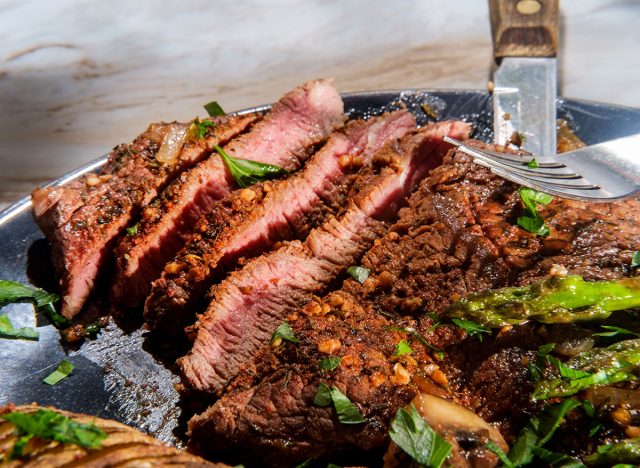

“This cut is one of my favorites!” says chef Machado. Vacio–more commonly referred to as “flap steak” in the U.S.– is one of the most popular steak cuts throughout Argentina and is a staple on the Novecento steakhouse menu alongside entraña.
Flap steak is often confused with flank steak since they are both very fine, come from the bottom sirloin, and are comparable price-wise. However, flap steak has a higher fat content, giving it a more tender texture.
“I usually butterfly it to make it easier and faster to cook, about 5-6 minutes per side. Make sure to cut against the grain for a much tender steak,” advises Machado. Butterflying a piece of steak involves cutting it in half but not all the way through so you’re left with two thinner halves that resemble a butterfly.
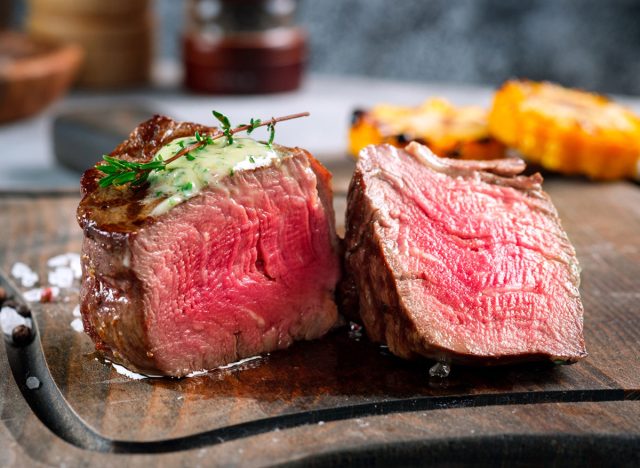

“Who isn’t impressed with a filet?” asks Ian Dodson, senior vice resident of culinary operations at J. Alexander’s Restaurants, which are known for wood-fired cuisine including mouthwatering steak cuts. Dodson says a filet is “uniform in size meaning it’s easier to cook” and its lack of fat also stops “flare-up flames” when grilling at home.
When you’re shopping for filets–or any kind of steak–it’s essential to get a good look at the cut you’re planning to purchase, he says. “Most supermarket steaks are a different grade than what you buy in a restaurant, people buy steaks that are bright red with a separate white fat cap, this means they have no fat marbling which give it flavor. You want the steak to have white streaks of fat running through the meat.”
And, when it comes to cooking your filet, the chef has no shortage of great suggestions. Grill the steak and don’t be afraid to get your grill real nice and hot for that beautiful all-over sear. If you don’t mind a bit of a messy kitchen, pan sauté your steak. Or, if you’re feeling exceptionally brave, the chef invites you to try sous vide–a cooking method where food is packaged in a vacuum-sealed bag and submerged in warm water for an extended period of time. Infuse the steak with garlic and rosemary and then afterward, let your grill or hot pan do the rest.








